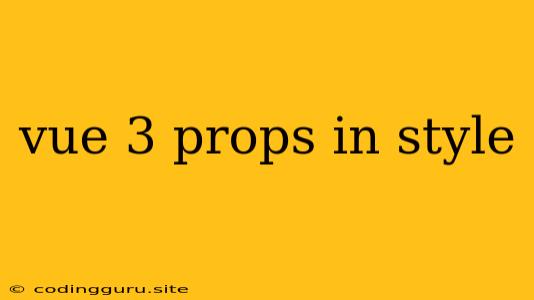Passing Data to Components: A Deep Dive into Vue 3 Props in Style
Vue.js, a progressive JavaScript framework, promotes the development of complex user interfaces with a focus on reusability and maintainability. Vue 3 introduces powerful new features, including a streamlined way to manage component styling using props. This guide delves into the concept of Vue 3 props in style and explores how to effectively leverage this technique for creating visually appealing and dynamic components.
What are Props?
Props, short for properties, are a mechanism for passing data from a parent component to a child component. Think of them as the communication channels between these components, allowing you to share information like text, numbers, images, or even more complex data structures.
Why Use Props?
Utilizing props in your Vue.js applications offers several advantages:
- Data Encapsulation: Props help maintain the separation of concerns between components. Each component is responsible for managing its own internal data, leading to cleaner code and easier debugging.
- Component Reusability: By passing data through props, components become more versatile and reusable. You can reuse the same component with different inputs to achieve varying outputs.
- Dynamic Styling: This is where props become particularly interesting. We can dynamically style components based on the data passed via props, leading to visually engaging and user-friendly interfaces.
Implementing Props in Style: A Practical Example
Let's consider a simple example to illustrate how Vue 3 props in style work. Imagine we're building a component to display a colored box. We want to pass the desired color as a prop.
Template (MyBox.vue)
{{ content }}
Script (MyBox.vue)
In this example:
- We define a
colorprop to receive the desired background color for the box. - We use the
:styledirective to dynamically apply thebackgroundColorbased on thecolorprop. - We also define a
contentprop to display text within the box.
Parent Component (App.vue)
In the parent component, we instantiate the MyBox component twice, providing different colors and content via the props. This demonstrates how props allow for dynamic styling and data-driven component rendering.
Beyond Basic Styling: Exploring Advanced Techniques
While the previous example demonstrates the basic concept, Vue 3 props in style can be used for much more sophisticated styling:
- Conditional Styling: You can dynamically apply different styles based on the value of a prop.
Example:
- Dynamic CSS Variables: You can use props to set CSS variables, allowing for global style modifications.
Example:
- Responsive Design: Use props to adapt styling based on device size or screen orientation.
Example:
Best Practices for Using Props in Style
To ensure clean and efficient implementation, follow these best practices:
- Prop Validation: Utilize the
propsobject to define the types and default values of your props. This helps prevent errors and promotes code clarity. - CSS Modules/Scoped Styles: Consider using CSS Modules or scoped styles to avoid naming conflicts and maintain style isolation within your components.
- Keep it Simple: Don't overcomplicate your styling logic. Aim for concise and understandable code.
Conclusion
Vue 3 props in style provide a powerful mechanism for creating dynamic and reusable components. By understanding how to effectively utilize props for styling, you can build visually appealing and user-friendly interfaces with greater efficiency and maintainability. Remember to follow best practices and experiment to unlock the full potential of this technique in your Vue.js applications.
